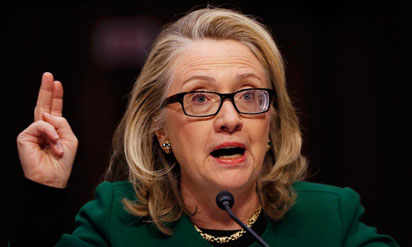Retired senior US military pilots are increasingly alarmed that Hillary Clinton’s proposal for “no-fly zones” in Syria could lead to a military confrontation with Russia that could escalate to levels that were previously unthinkable in the post-cold war world.
The former strategists spoke to the Guardian as Clinton’s Republican rival Donald Trump warned that Clinton’s proposal to establish “safe zones” to protect beleaguered Syrian civilians would “lead to world war three”.
The proposal of no-fly zones has been fiercely debated in Washington for the past five years, but has never attracted significant enthusiasm from the military because of the risk to pilots from Syrian air defenses and the presence of Russian warplanes.
Many in US national security circles consider the risk of an aerial confrontation with the Russians to be severe.
“I wouldn’t put it past them to shoot down an American aircraft,” said James Clapper, the US director of national intelligence, on Tuesday in response to a question from the Guardian at the Council on Foreign Relations.
Those who have patrolled no-fly zones over the relatively freer skies of Bosnia and Saddam-era Iraq fear that a President Clinton would oblige the US to what one retired US air force three-star general described as an indefinite “air occupation”. Such a move would risk the lives of US pilots – and dare confrontation with a Russian military which is more aggressive than it has been in years.
Critics of the plan also question how using US military power to establish and police a safe space for beleaguered Syrian civilians would contribute to the downfall of President Bashar al-Assad – the explicit goal of US policy in Syria.
“If she is not politically posturing, it’s going to be a disaster. I hope it’s political posturing,” said John Kuehn, a retired navy officer who flew no-fly zone missions over Bosnia and Iraq. Kuehn who called denying an adversary its airspace “the cocktail party military application of power of choice”.
David Deptula, a retired air force lieutenant general who commanded the no-fly zone operations over northern Iraq in 1998 and 1999, said the Russians were a “complicating factor” but considered the problems with a no-fly zone to be more fundamental.
“Until a strategy that defines the desired end-state is clearly laid out in a comprehensive way, it’s difficult to advocate for a no-fly zone,” said Deptula.
“Right now, the way it’s being discussed, it’s a solution in search of a strategy. Until coalition powers define what it is they wish to accomplish, banding about a solution like a no-fly zone is a non-starter.”
The challenges for a no-fly zone over Syria outstrip those the US has faced over Libya, Bosnia and Iraq. Assad’s surface-to-air missiles, protecting the Mediterranean coast and southern regions the regime still controls, were formidable before the recent Russian addition of what Clapper, a former air force general, called “very advanced” S-300 and S-400 systems that can blanket the majority of Syrian airspace with missiles.
Staging a no-fly zone requires either the assent of regional allies – Turkey is the nearest potential partner to Syria, but it has concentrated in recent months on improving ties with Moscow after Turkish forces shot down a Russian jet in November 2015 – or an expensive, open-ended and risky deployment of aircraft carrier groups to the eastern Mediterranean.
But the most distinguishing feature of a Syria no-fly zone in 2017 would be the aerial presence of another great-power air force with an objective which is diametrically opposed to Washington’s.
Russia and the US currently share the skies above Syria and maintain a military-to-military communication channel to avoid confrontation.
But since they operate over different parts of the country and with different objectives – the US in the east against the Islamic State, Russia to the west against Assad’s opposition – a US-imposed no-fly zone would put their objectives into conflict. No one knows how either side would respond if Russian aircraft violated a US air cordon, nor how to de-escalate a clash before it spiraled into extended combat.
Russia said on Tuesday that it would continue a moratorium on air strikes in the besieged city of Aleppo, but local sources said that rebel-held neighbourhoods had been struck in recent days.
Kuehn, now a professor of military history at the US Army Command and General Staff College, said that escalation could occur by accident, either through a direct confrontation in the air, or through a Syrian or Russian capture of a downed US pilot.
“I see almost nothing positive that can come from implementing [a no-fly zone] at the current time over Syria. Conversely, the potential to make a bad situation worse is very, very high,” Kuehn said.
For years, senior US military officers have expressed reluctance to intervene in the Syrian civil war. In 2013, Martin Dempsey, then the chairman of the joint chiefs of staff, said that even a limited safe zone would cost over $1bn a month and require substantial air assets and ground troops to maintain. His successor, Joseph Dunford, told the Senate last month that a no-fly zone would “require us to go to war against Syria and Russia” before walking his assessment back under pressure from proposal advocate John McCain.
Clinton, who has long backed a no-fly zone as the Syrian bloodshed has accumulated, acknowledged those concerns in last week’s third presidential debate.
“I’m going to continue to push for a no-fly zone and safe havens within Syria not only to help protect the Syrians and prevent the constant outflow of refugees,” Clinton said, “but to, frankly, gain some leverage on both the Syrian government and the Russians so that perhaps we can have the kind of serious negotiation necessary to bring the conflict to an end and go forward on a political track.”
But strategists have a hard time understanding how a no-fly zone provides the US with a large enough leverage to trade with Assad or Russia, given their objective is, respectively, self-preservation and the preservation of a client.
“I don’t understand how a no-fly zone gets you to a political settlement. There’s no history supporting that. There were no-fly zones in Iraq for close to a decade and it settled nothing,” said Joshua Rovner of Southern Methodist University.
“I wish this would be the kind of leverage she seems to hope it is, but I don’t see why this would pose a serious threat to Assad or Putin. It’s accepting a lot of new costs with very few benefits.”
(Vanguard )






